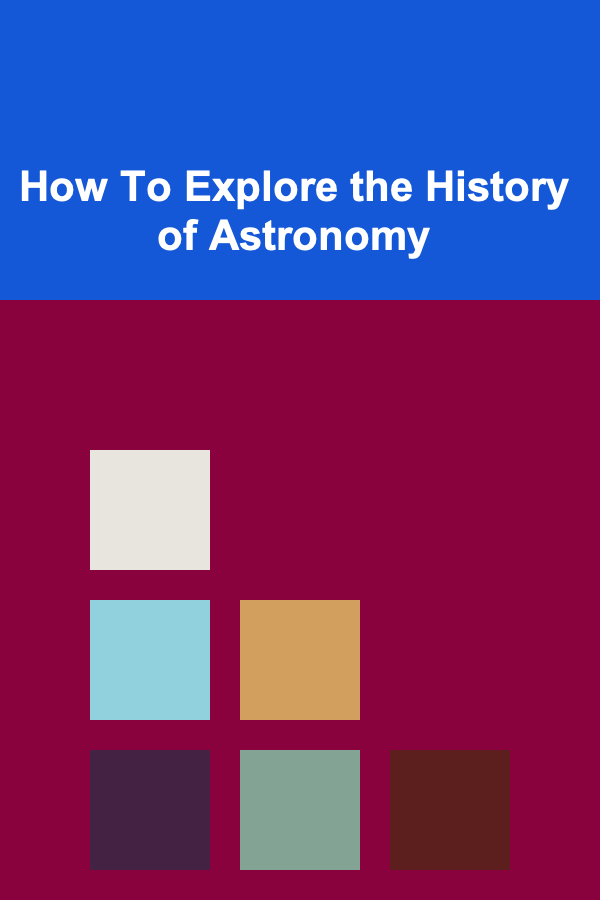
How To Explore the History of Astronomy
ebook include PDF & Audio bundle (Micro Guide)
$12.99$11.99
Limited Time Offer! Order within the next:

Astronomy is one of the oldest sciences known to humanity, stretching back to the dawn of civilization. For millennia, humans have gazed up at the stars, seeking to understand the cosmos and our place within it. The history of astronomy is rich, multifaceted, and constantly evolving as our tools, knowledge, and understanding of the universe expand. In this article, we will delve into how one can explore the history of astronomy, from the ancient civilizations that laid the foundation to the modern discoveries that continue to shape our understanding of the universe.
The Origins of Astronomy
Ancient Civilizations and Early Observations
The history of astronomy can be traced back to ancient civilizations, where people first sought to make sense of the celestial bodies. Early astronomical observations were often linked to religious practices, navigation, and the agricultural calendar. The Egyptians, Babylonians, and Mayans, for instance, were among the earliest astronomers, using the stars and planets to create calendars and predict seasonal changes.
In ancient Egypt, the alignment of the Great Pyramid of Giza with the stars in the constellation Orion shows a sophisticated understanding of the night sky. The Babylonians were the first to systematically record planetary movements, with their astronomical tablets from the 6th century BCE detailing the positions of the five visible planets.
The Mayans also made remarkable strides in astronomy, particularly with their development of the Mayan Long Count calendar, which was based on an intricate understanding of the solar cycle and the movements of celestial bodies.
Ancient Greece: The Birth of Theoretical Astronomy
Ancient Greek philosophers took astronomy to new heights, marking the transition from mere observational astronomy to a more theoretical and scientific approach. One of the most significant figures in ancient Greek astronomy was Pythagoras, who proposed that the Earth was spherical, a revolutionary idea at the time.
Aristotle, another Greek philosopher, further advanced the field by providing a geocentric model of the universe, in which Earth was at the center, and the stars and planets orbited around it. This idea, known as the Aristotelian cosmology, dominated Western thought for over a millennium.
However, it was the work of Claudius Ptolemy, a Greek astronomer in Egypt, that had the most enduring influence on astronomy for centuries. Ptolemy's "Almagest" compiled astronomical data and presented a detailed geocentric model that was used for over 1,400 years. His model, although incorrect, provided a framework for understanding celestial motions.
The Middle Ages and the Islamic Golden Age
Preservation and Enhancement of Ancient Knowledge
During the Middle Ages, the study of astronomy in Europe was relatively stagnant due to the dominance of the Church, which often viewed scientific exploration with suspicion. However, the Islamic world played a crucial role in preserving and advancing the knowledge of ancient Greek and Roman astronomers. Scholars in the Islamic Golden Age (8th to 14th century) translated and built upon the works of Ptolemy and others, preserving valuable astronomical texts that would later be rediscovered in the Renaissance.
One of the most significant figures in Islamic astronomy was Al-Battani, whose precise observations and calculations of the Sun's movement improved upon Ptolemy's model. His works were influential in both the Islamic world and Europe, where they were later translated into Latin.
Alhazen (Ibn al-Haytham) is another key figure in the history of astronomy. He made foundational contributions to optics and visual perception, which had important implications for astronomical observations. His work on the nature of light and the behavior of reflection and refraction laid the groundwork for later developments in telescopic astronomy.
Astronomical Instruments and Observatories
During the Islamic Golden Age, astronomers also developed new tools and methods for observing the stars. The astrolabe, a device used for determining the positions of celestial bodies, became a popular instrument in both the Islamic world and Europe. Astronomical observatories were built in cities like Baghdad, Damascus, and Samarkand, where astronomers could make precise measurements of the sky.
One of the most famous observatories of this period was the Maragheh Observatory in Persia, established by Nasir al-Din al-Tusi in the 13th century. The observatory housed advanced instruments for observing the night sky and contributed to the development of a more accurate astronomical model.
The Renaissance and the Birth of Modern Astronomy
Copernicus and the Heliocentric Revolution
The dawn of the Renaissance marked a turning point in the history of astronomy. The rediscovery of ancient Greek texts, combined with new advances in mathematics and technology, allowed for a reevaluation of the Earth's place in the cosmos. The most revolutionary idea to emerge during this time was the heliocentric model of the solar system, proposed by Nicolaus Copernicus in the 16th century.
Copernicus's model placed the Sun at the center of the solar system, with Earth and the other planets orbiting around it. This was in stark contrast to the geocentric model that had been accepted for over 1,400 years. While Copernicus's ideas were not immediately accepted, his work laid the foundation for future breakthroughs in astronomy.
The Telescope and the Work of Galileo
The invention of the telescope in the early 17th century revolutionized the study of astronomy. Galileo Galilei was one of the first astronomers to use the telescope for celestial observations. In 1609, Galileo turned his telescope toward the night sky and made a series of groundbreaking discoveries, including the moons of Jupiter, the phases of Venus, and the rugged surface of the Moon. These observations provided strong evidence for the heliocentric model and challenged the traditional geocentric view.
Galileo's discoveries were met with resistance from the Catholic Church, which upheld the geocentric model. In 1633, Galileo was tried by the Inquisition and forced to recant his views, but his work had already set the stage for a new era in astronomy.
Kepler and the Laws of Planetary Motion
Johannes Kepler, a German astronomer, further advanced the heliocentric model by formulating his three laws of planetary motion. Kepler's laws, based on meticulous observations made by Tycho Brahe, described the elliptical orbits of planets and provided a more accurate understanding of planetary motion. Kepler's work dispelled the idea of circular orbits and set the stage for Isaac Newton's laws of motion and universal gravitation.
The Age of Enlightenment and the Development of Modern Astronomy
Newton and the Laws of Motion
Isaac Newton's work in the late 17th century brought together the findings of Copernicus, Galileo, and Kepler into a unified theory of motion. Newton's "Philosophiæ Naturalis Principia Mathematica," published in 1687, introduced the laws of motion and universal gravitation, which explained the forces governing the motion of celestial bodies.
Newton's laws provided the framework for understanding both the motion of planets and the forces acting on objects on Earth. His work revolutionized physics and astronomy, and it remained the cornerstone of scientific understanding until the early 20th century.
The Development of Telescopic Technology
The 18th and 19th centuries saw significant advances in telescopic technology. The invention of the reflecting telescope by Isaac Newton himself in 1668 allowed for clearer and more detailed observations of the night sky. In the 19th century, the development of large observatories, such as the Royal Greenwich Observatory in England and the Mount Palomar Observatory in California, allowed astronomers to study the heavens with unprecedented accuracy.
One of the most important discoveries of this era was the identification of new planets and celestial bodies. In 1781, William Herschel discovered the planet Uranus, the first planet to be discovered with a telescope. Later, in the 19th century, astronomers also discovered Neptune and Pluto, further expanding our knowledge of the solar system.
The 20th Century and the Modern Era of Astronomy
The Theory of Relativity and the Expanding Universe
The 20th century marked the beginning of modern astronomy, with groundbreaking discoveries that reshaped our understanding of the universe. Albert Einstein's theory of relativity, published in 1915, revolutionized our understanding of space, time, and gravity. Einstein's theory predicted the bending of light by massive objects, an idea that was confirmed in 1919 when British astronomers observed the bending of starlight around the Sun during a solar eclipse.
In the 1920s, Edwin Hubble made a groundbreaking discovery about the nature of the universe. By observing the redshift of light from distant galaxies, Hubble concluded that the universe was expanding. This discovery provided the basis for the Big Bang theory, which suggests that the universe began as a singularity and has been expanding ever since.
The Space Age and the Exploration of the Cosmos
The space age, which began with the launch of the Soviet Union's Sputnik 1 in 1957, ushered in a new era of astronomical exploration. The development of space telescopes, such as the Hubble Space Telescope, allowed astronomers to observe distant galaxies, nebulae, and other celestial phenomena with unprecedented detail.
In addition to space telescopes, robotic spacecraft have traveled to other planets in our solar system, including Mars, Venus, and Jupiter. These missions have provided valuable data on the composition and history of other worlds, helping scientists to better understand the formation and evolution of the solar system.
The Search for Extraterrestrial Life
One of the most exciting areas of modern astronomy is the search for extraterrestrial life. Advances in technology have allowed astronomers to detect exoplanets, planets that orbit stars outside our solar system. The discovery of potentially habitable exoplanets has raised the possibility of finding life beyond Earth.
Astrobiology, the study of life in the universe, is a rapidly growing field that seeks to answer one of humanity's most profound questions: Are we alone in the cosmos? As telescopes and space probes continue to gather data, the search for life beyond Earth remains one of the most exciting frontiers in astronomy.
Conclusion: The Ongoing Exploration of the Cosmos
The history of astronomy is a testament to human curiosity and ingenuity. From the ancient observations of the stars to the modern-day exploration of distant galaxies, our understanding of the universe has grown exponentially. Yet, there is still so much to discover.
As technology advances and our tools become more powerful, the future of astronomy holds limitless potential. The search for life on other planets, the study of black holes, the exploration of the cosmos' origins---these are just a few of the many exciting frontiers that await us. For anyone interested in exploring the history of astronomy, it is essential to recognize that this is not just a story of the past, but a journey that continues to unfold with each new discovery.

How to Add Texture to Your Home Using Affordable Materials
Read More
How to Organize Your Art Supplies for Easy Creativity
Read More
How to Organize Your Holiday Cards for Easy Sending
Read More
How to Set Up a Checklist for Effective Event Promotion for Fundraising
Read More
How to Use Tax-Loss Harvesting to Offset Capital Gains Taxes
Read More
How to Monetize Your Mobile App: Strategies for Success
Read MoreOther Products

How to Add Texture to Your Home Using Affordable Materials
Read More
How to Organize Your Art Supplies for Easy Creativity
Read More
How to Organize Your Holiday Cards for Easy Sending
Read More
How to Set Up a Checklist for Effective Event Promotion for Fundraising
Read More
How to Use Tax-Loss Harvesting to Offset Capital Gains Taxes
Read More